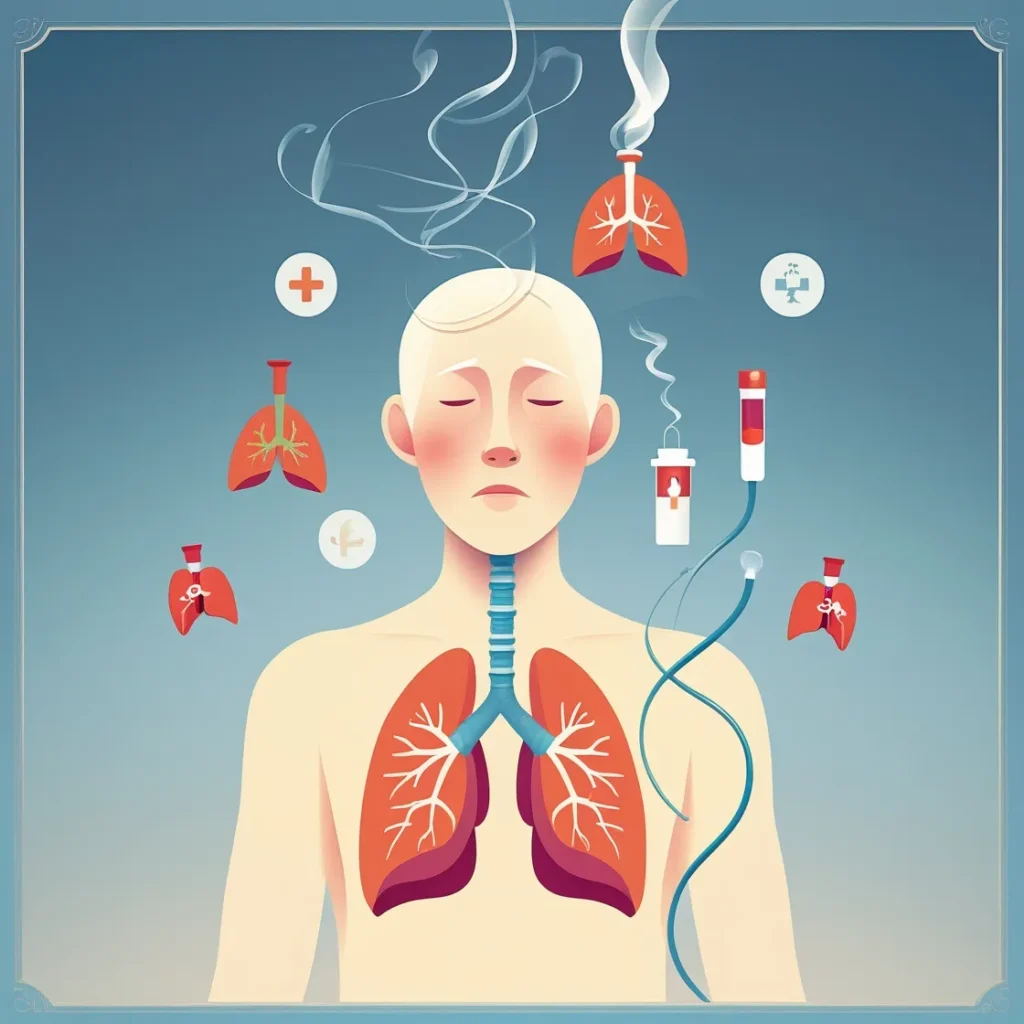COPD: Early Symptoms, Risk Factors, and Prevention
COPD: Early Symptoms, Risk Factors, and Prevention. Chronic obstructive pulmonary disease is a common lung condition caused by damage to the lung’s airways or other parts that restricts airflow and makes breathing difficult. It is associated with structural lung changes caused by long-term, inflammation from exposure to harmful particles, mainly cigarette smoke. The symptoms include tiredness, wheezing, breathing difficulties, and coughing, usually with phlegm.
Chronic obstructive pulmonary disease (COPD) is a common lung condition caused by damage to the lung’s airways or other parts. This damage restricts airflow and makes breathing difficult.
It is associated with structural lung changes caused by long-term, chronic inflammation from exposure to harmful particles or gases, most frequently cigarette smoke. Chronic inflammation leads to the narrowing of airways and decreased lung recoil. Individuals suffering from COPD may experience lung damage or phlegm formation. The symptoms include tiredness, wheezing, breathing difficulties, and coughing, usually with phlegm. Symptoms may vary from being asymptomatic (no symptoms) to respiratory failure.

COPD meaning
The word “chronic” is coined from the Greek word “Chronos,” meaning it is long-lasting. The word “obstructive” is derived from the Latin word obstruere,” meaning having the quality of obstructing, serving, or intending to hinder. The word “pulmonary” is derived from the Latin word “pulmonarius,” meaning the lungs. The word “disease” is derived from the Latin word meaning sickness or illness.
Obstructive pulmonary disease
COPD: Early Symptoms, Risk Factors, and Prevention. Obstructive pulmonary diseases are diseases of the respiratory system characterized by limitation of airflow due to airway obstruction at different levels, most of them at the bronchior bronchioles. It often results in inflamed and easily collapsible airways, obstruction to airflow, and problem exhaling. The characteristic finding is reduced forced expiratory volume at 1 s (FEV1) with normal total lung capacity and forced vital capacity (FVC). By definition, disease has an FEV1/FVC ratio of < 0.8.
In the United States, about 16 million people have chronic obstructive pulmonary disease (COPD). It is a common cause of death, accounting for more than 140,000 deaths each year.
Worldwide, the number of people with COPD is increasing. Factors contributing to COPD include an increase in smoking in many countries and, throughout the world, exposure to toxins in biomass fuels such as wood and grass. Death rates may be increasing in medically underserved countries.
COPD leads to a persistent decrease in the rate of airflow from the lungs when the person breathes out (exhales), which is called chronic airflow obstruction. COPD includes the diagnoses of chronic obstructive bronchitis and emphysema. Many people have both disorders.
- Chronic bronchitis is defined as cough that produces sputum for at least 3 months during 2 successive years. When chronic bronchitis involves airflow obstruction, it qualifies as chronic obstructive bronchitis.
- Emphysema is defined as widespread and irreversible destruction of the alveolar walls (the cells that support the air sacs, or alveoli, that make up the lungs) and enlargement of many of the alveoli.
Chronic asthmatic bronchitis is similar to chronic bronchitis. In addition to having a cough that produces sputum, people have wheezing and partially reversible airflow obstruction. It occurs predominantly in people who smoke and have asthma. Some people have both COPD and asthma. People with both disorders are treated primarily for asthma.
The small airways (bronchioles) of the lungs contain smooth muscles and are normally held open by their attachments to alveolar walls. In emphysema, the destruction of alveolar wall attachments results in collapse of the bronchioles when a person exhales, causing airflow obstruction that is permanent and irreversible. In chronic bronchitis, the glands lining the larger airways (bronchi) of the lungs enlarge and increase their secretion of mucus. Inflammation of the bronchioles develops and causes smooth muscles in lung tissue to contract (spasm), further obstructing airflow. Inflammation also causes swelling of the airway passages and secretions in them, further limiting airflow. Eventually, the small airways in the lung become narrowed and destroyed. Asthma is also characterized by airflow obstruction. However, unlike airflow obstruction in COPD, airflow obstruction in asthma is completely reversible in most people, either spontaneously or with treatment.
Causes of COPD
The most important cause of COPD is
- Cigarette smoking
Cigarette Smoking and Emphysem…
Only about 15% of people who smoke develop COPD. With aging, susceptible people who smoke cigarettes lose lung function more rapidly than people who do not smoke. Lung function improves only a little if people stop smoking. However, the rate of decline of lung function returns to that of people who do not smoke when people stop smoking, thus delaying the development and progression of symptoms.
Working in an environment polluted by chemical fumes or dust or by heavy smoke from indoor cooking fires may increase the risk of COPD (see Overview of Environmental and Occupational Lung Disease). Exposure to air pollution and to smoke from people who are smoking cigarettes nearby (secondhand or passive smoke exposure) may cause flare-ups in people who have COPD but probably does not cause COPD.
COPD tends to occur more often in some families, so there may be an inherited tendency in some people.
Low body weight and childhood respiratory disorders contribute to the risk of COPD. However, these factors are of much less importance than cigarette smoking.
Symptoms associated with COPD
- Troubled inhalation,
- Shortness of breath, especially during activity,
- Wet cough (phlegm present),
- Wheezing.
Risk factors of COPD
- History of asthma,
- Genetic factors (alpha-1-antitrypsin deficiency),
- Exposure to tobacco (the longer you smoke or are exposed to tobacco smoke, the higher the risk to develop COPD),
- Exposure to dust/chemicals/fumes.
Complications associated with COPD
- COPD increases the risk of infections/pneumonia,
- Pulmonary hypertension,
- Increased risk of cardiac disease,
- General poor health status,
- Exercise intolerance,
- Anxiety,
- Depression.
Prevention of COPD
Unlike most diseases, the causes/risk factors leading to the development of COPD are clear. Here are some ways to protect yourself and prevent the worsening of symptoms:
- Quit smoking,
- Wear protective gear if you are exposed to dust, fumes, or chemicals at your workplace.
- It is recommended that patients should receive their annual flu shots and meet regularly with their primary healthcare physician to get booster shots against pneumonia-causing bacteria (Streptococcus pneumonia).
Diagnostic methods of COPD
First and foremost, the primary healthcare physician will take a complete patient history (symptoms, family history, cigarette smoking, exposure to irritants, etc.) in order to have as much information because COPD is commonly misdiagnosed until it’s at an advanced stage. Second, the physician will request PFTs (pulmonary function tests), chest X-rays, and blood tests (testing for alpha-1-antitrypsin deficiency).
Best Gluten-Free Chips: Top Brands & Tasty Picks. If like me you’re a huge savoury fan, you’re probably always on the hunt for a bag of gluten free crisps to devour.
Treatments
- Short-acting bronchodilators (i.e., Albuterol),
- Long-acting bronchodilators (i.e., Salmeterol),
- Inhaled corticosteroids (i.e., Budesonide),
- Antibiotics in the case of infection,
- Phosphodiesterase-4-inhibitors (i.e., roflumilast),
- Oxygen therapy and lung rehabilitation/exercises.
Here are 5 FAQs about COPD (Chronic Obstructive Pulmonary Disease):






